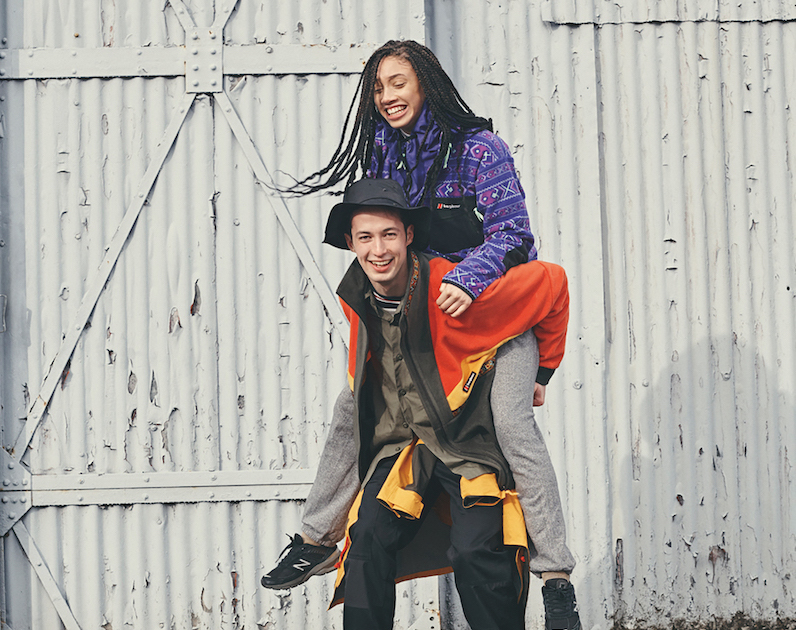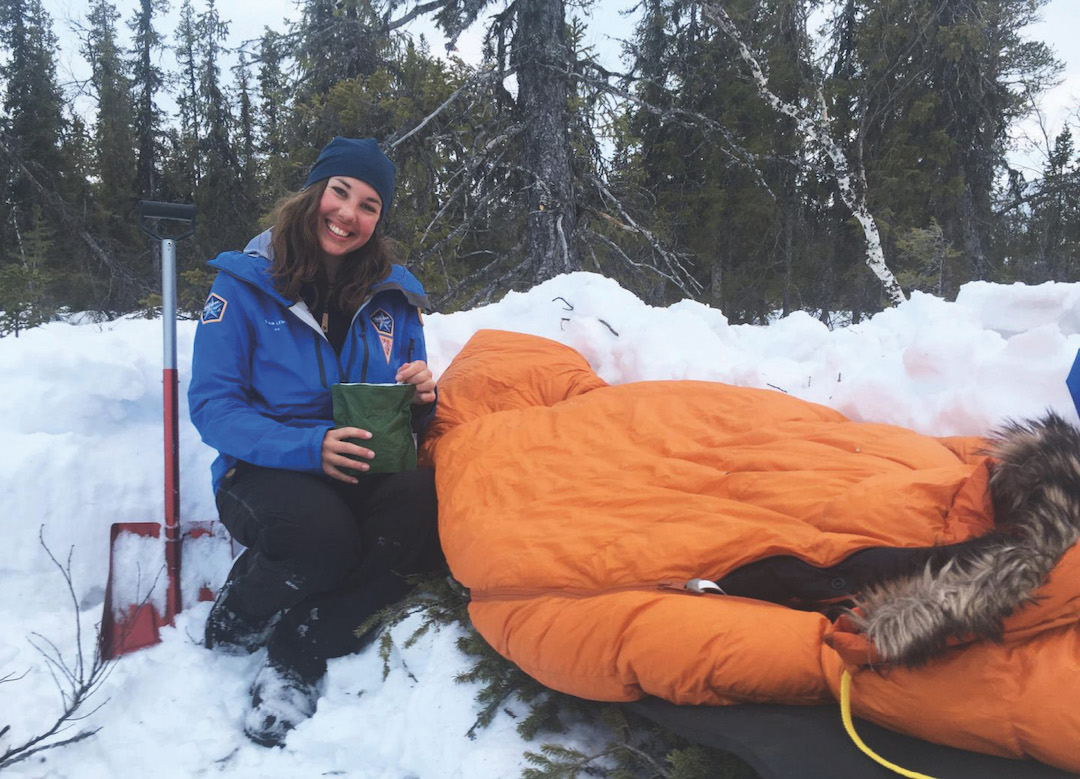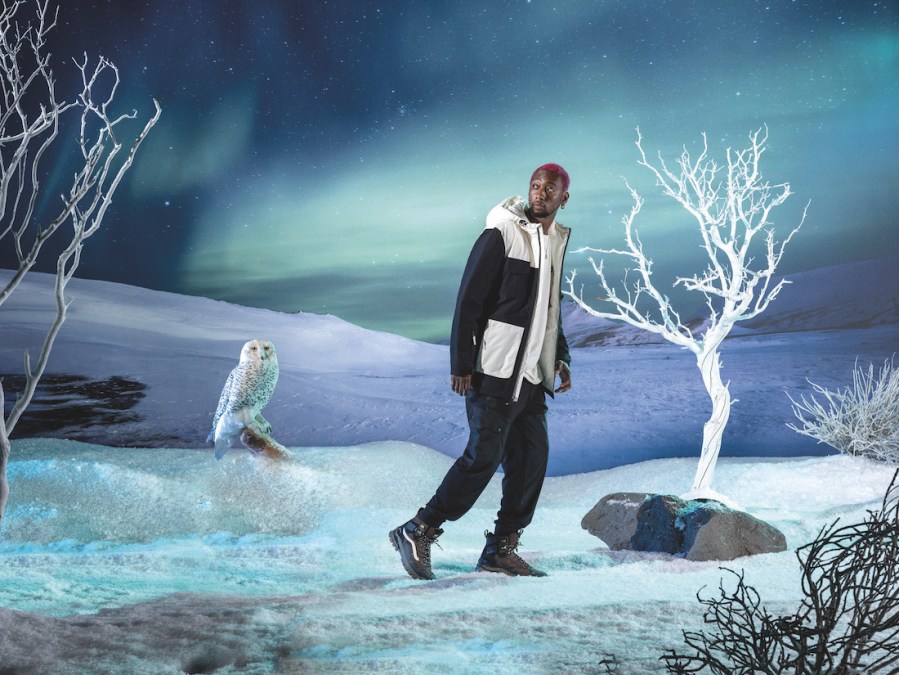In recently years, technical outdoor clothing has made an unlikely leap into the mainstream, becoming the style of choice for Tik Tok teens, high fashion brands and rappers. James Forrest looks into how this happened – and asks what it means for the industry.
Main image: the Ultra collection from Vans is a real hoot (sorry…). Photo: Vans
A new TikTok trend has gone viral – and, bizarrely, it involves teenagers wearing expensive Arc’teryx jackets in the shower and showing off how well the water droplets bead.
One video by 18-year-old user @laulauchichi has been viewed 3.1 million times with over 500,000 likes, and hundreds of similar clips are equally as popular. To add to the peculiarity, all of these videos are set to a song by London-based hip-hop artist YT called Arc’teryx – a track that features the lyrics “Arc’teryx on me no we don’t rock no Patagonia, Arc’teryx on me I could go hiking in Snowdonia”. What the hell is going on?
@laulauchichi @arcteryx ♬ Arc’teryx – YT
But, then again, perhaps it’s not surprising TikTok teens are getting involved. Over the past decade the worlds of hiking clothing and high-end fashion have developed an unlikely kinship, with brands such as The North Face, Patagonia (despite what YT says) and Canada Goose proving as in vogue and desirable as ‘proper’ fashion labels. “This summer it’s all about dressing like you’re on the way to the Lake District” announced a 2019 headline in Esquire, with images of hip hop artist Frank Ocean sporting a Mammut down jacket and an Arc’Teryx beanie.
Prevalence
The Great Outdoors gear editor and prolific long-distance walker Chris Townsend has watched this trend emerge, but he stresses that it is a pattern which tends to recur every so often. “This isn’t new”, he says. “Back in the 1990s I remember the bizarre sight of Oasis wearing down jackets on Top of the Pops. In the eighties and nineties fleece went from technical mountain wear to fashion and then to general leisurewear with amazing speed. But it does seem to be much more prevalent now.”
Some brands have found their products ‘accidentally’ getting mainstream appeal, but for others, the has been a deliberate marketing strategy, with CEOs consciously courting the mainstream for the riches it can reap compared to the niche market of hillwalkers and climbers.
A classic example is Canada Goose, which was known in the 70s and 80s for its highly-technical parka jackets and snowmobile suits, before new chief executive Dani Reiss transformed it into a global fashion brand in the 2000s, using film partnerships and ‘cultural marketing’ to crack the luxury lifestyle market. And in some cases, the reverse process has happened, with mainstream fashion brands incorporating elements of the outdoor ‘look’ into their mainstream products – see the Vans ‘Ultra’ range, for example and their footwear collaborations with surfing and outdoor brand Finisterre.
The North Face is another commonly cited example of the outdoors-to-fashion transition. In 2020, the brand’s retro Nuptse down puffer jacket was named “the hottest product in the world” by global fashion search platform Lyst, with celebrities including Kanye West, Kendal Jenner and Emily Ratajkowski spotted wearing it. In the same year, the brand launched a head-turning collaboration with Gucci, featuring actor Jared Leto. Berghaus’s ‘Dean Street‘ collection, aimed at the high street, harkens back to the brand’s 80s and 90s stylings.

The Berghaus ‘Dean Street’ collection – evoking 80s and 90s stylings. Photo: Berghaus
Credibility
But does achieving street credibility compromise a brand’s technical credibility? Some argue it inevitably does, complaining that logos, colourways and styling end up being prioritised over technical performance. But other brands do manage to achieve a lucrative mix of fashionability and technical performance. Patagonia and Arc’teryx, for instance, both regularly produce products that meet with warm receptions from outdoor gear reviewers (including in The Great Outdoors). Some brands opt to provide a clear distinction between their technical lines and fashion ranges – Berghaus’s Dean Street collection being a good example.
The reaction of the hillwalking and climbing community to seeing the products they use suddenly turn up on the catwalk can be polarised. Bemusement, or even anger, is a common reaction, with some hikers or climbers perhaps fearing that the temptations of mainstream success will lead brands to compromise the quality of their products, or perhaps because of a discomfort with a niche culture being popularised by ‘outsiders’.
Positives
Others, however, see positives in this trend, particularly if it makes the outdoors more inclusive and accessible. Sian Lewis, author of The Girl Outdoors: The Wild Girl’s Guide to Adventure, Travel and Wellbeing, says: “I’ve seen hiking kit go from anorak-y to super trendy in the last ten years – these days all of my mates, outdoorsy or not, are sporting North Face gilets, Finisterre insulated jackets and stompy hiking boots just to nip to Tesco.

Sian Lewis on a winter wild camp. Photo: Sian Lewis
“I do like that more women’s adventure kit looks flattering, and comes in smart colourways, these days. Some brands such as Patagonia or Fjallraven produce clothing that manages to be both weatherproof and good-looking, and I think if you’re investing in a really good pair of hiking boots or a hardy jacket, you might as well pick something that also looks good down the pub when you’re back off the mountain, to make your purchase go further.
“But other brands are making kit that is clearly more about fashion than functionality (North Face x GUCCI collection, I’m looking at you), and that seems totally pointless – and straying into fashion victim territory – to me.”
But Sian points out that there are two different kinds of shoppers out there. She says: “Experienced outdoors types usually know their Gore-Tex from their goose down, and beginner adventurers will find good buying guides online, so hopefully that leaves the leaky leather-style boots and fluffy-but-not-functional fleeces to those who want the hiking look without actually hitting the trail!”
And as Chris points out: “Overall I think it’s better for actual outdoor clothing to be fashionable than for fashion brands to copy outdoor clothing with products unsuitable for the hills and mountains.”








